Bac Ninh folk song, one of the typical folk songs of the North cultural region, has been designated as an intangible cultural asset of mankind by UNESCO, and it is also a distinctive highlight of Vietnamese art that everyone is proud of. This page will help you understand more about the peculiarities of Bac Ninh folk music.
1. What is Bac Ninh Folk Song?
Bac Ninh Folk Song is a folk of the North’s Hong River Delta, originated and evolved in the historic Kinh Bac cultural zone, particularly the border area between Bac Giang and Bac Ninh today. The Cau River, sometimes known as the Quan Ho River, now runs through the area.
According to the theory, “Quan Ho” is a “mandarin family” music genre that deserves to be named by such a distinctive name. According to folklore, a horse-riding official was travelling through the village of Diem Xaa (Hoa Long commune, Yen Phong district, Bac Ninh province) when he came upon a girl performing traditional songs. He came to a halt to listen since he was so enthralled by the song. Finally, he came up with the name “Quan Ho”.
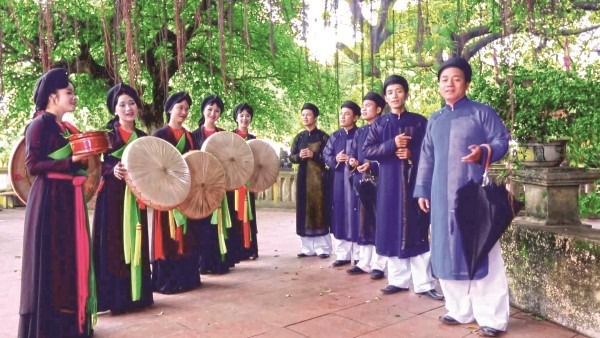
According to Vu Ngoc Khanh and Pham Minh ThaoQuan Ho folk music can be categorized into six types in their book “Treasures of Vietnam Folk Singers.”
- Hoi Singing (singing Quan ho at the festival)
- Happiness Singing (Singing Quan Ho at the meeting)
- Worshiping Singing (Singing Quan Ho at communal house and temple door).
- Canh Singing (singing Quan ho at home between two groups of Mandarins, boys, and girls, who invite each other).
- The phrase resolution singing (singing after the completion of the term resolution ceremony)
- Cau Dao Singing and Rain Prayer (Singing to pray for the high heavens and gods for favorable rain and good crops).
In six types of Quan Ho folk singing listed Hoi singing and Canh singing is the two most well-known, with great artistic and cultural value, drawing visitors from all over the world to enjoy.
2. The original folk music of Quan Ho Bac Ninh
To date, the opinions on the origins of Quan Ho Bac Ninh Folk music remain unknown because of various views, including that of Quan Ho folk they originated in the 11th century, others in the 17th century, but all these opinions have confirmed the tremendous value of the intangible cultural heritage of humanity.
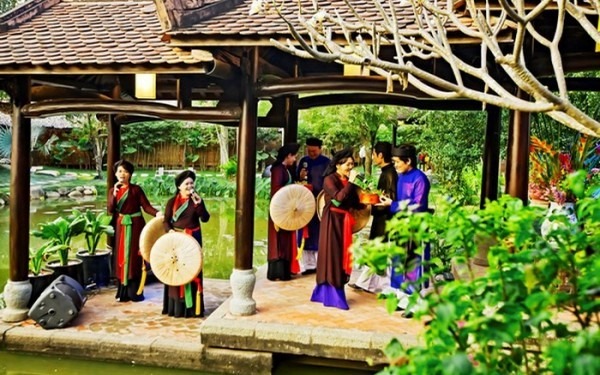
Before the August Revolution of 1945, there were 49 villages, according to an inquiry by the Ha Bac Department of Culture (in present-day Bac Ninh and Bac Giang provinces). Tien Du, Hiep Hoa, Yen Dung, Yen Phong, Tu Son, and Bac Ninh were among the cities where they were found. Each town in Bac Ninh has its distinct personality, enticing visitors who come to hear the locals perform traditional music.
3. Quan Ho’s distinct perspectives, Bac Ninh’s traditional music
3.1. The tone captivates people’s hearts
Quan Ho Bac Ninh’s folk song is performed in a lovely, delicate voice. Everyone admires the irresistible allure of this classic folk song because the singer expertly breathes life into each phrase, imbuing the complete song with a distinct feeling that makes the sound of the whole song always resonate and permeate the hearts of people who love it.
“La rang,” “Duong ban Kim Loan,” and other old Quan Ho tunes that people are likely to desire to learn, for example, Cay Gao”, “Gia ban,” “Hu La,” “La Hoi,” “Tinh tang,” “Cai a,” “Len Nui,” “Cai Hon,” “Xuong Song,” “Gio mat Trang Thanh”, “Tu Quy”.
3.2. The distinctive vocal style
With their distinctive method of singing doubles, Bac Ninh folk melodies have captivated the listener. When one of you sings, the other side prepares a pair of singers who will sing oppositely. As a result, singing mandarins is an elegant kind of singing. Mandarin singers are sometimes referred to as brothers and sisters.
Meanwhile, each dance was made up of fraternities, which started with personal queries or appeals and ended with meetings in the south, where they could sing all night to express their thoughts while helping each other get to know each other.
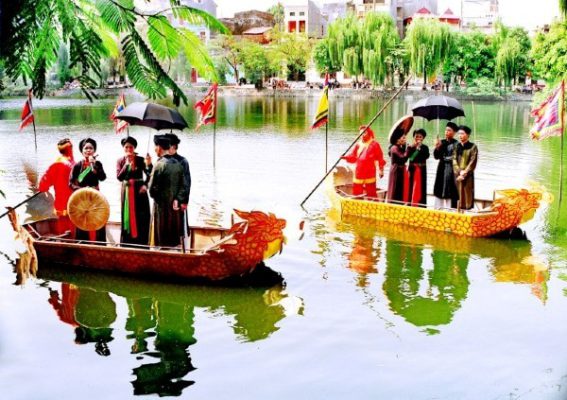
They were then separated into pairs based on their voice and tone consistency: Big Brother and Elder Sister, Brother Hai and Sister Hai, Brother Ba and Sister Ba, and so on. The words of the Bac Ninh folk song are mostly about the couple’s love and devoted commitment. In truth, they do not consider love, but rather partnerships based on mutual respect. They address each other as brother, sister, you, or me.
Bac Ninh’s Quan Ho folk song is lyrical music, therefore the style of singing and singing is meticulously crafted, including a variety of ways to ensure that the melody reverberates, reverberates in the background, bounces, and sounds like honey. Sweet adoration into the ear The yard of the home, in front of the community house, the temple entrance, on the boat, at the water dock… are all common locations for singing Quan ho Bac Ninh folk song.
3.3. The outfit of Quan Ho Bac Ninh folklore is distinctive
The peculiarities of the Bac Ninh folksong are created by the traditional clothing, which include those of the brothers and sisters.
The brothers’ attire consists mostly of a black five-body long dress made of salary cloth, which is worn with one or two blouses.
Their trousers are naturally white, broad tubes, sewed to the ankles using fabrics made of phin, truc, or silk, in contrast to the color of their shirt.
In addition, one of the hallmarks of traditional clothes in Quan Ho folk songs is the conical hat in the shape of a standard leaf or pineapple top. This is a must-have item for any brother: it simply reflects the man’s personality. Bringing traditional Vietnamese culture and the region’s distinct qualities together is a winning mix.
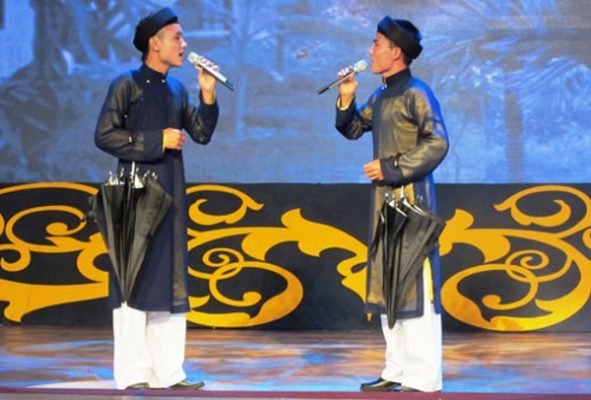
Meanwhile, the sisters’ ao dai garment is known as the “three-piece seven,” referring to the fact that they search for three interconnecting tunics (threesomes) or seven interlocking tunics (the sevens).
Outside of a white or ivory wing dress, the sisters’ basic costume consists of a brilliantly colored ao yem (used for middle age) or yem on the rim (used for ladies) with a silk truss material.
Sisters commonly wear a five-body tunic with a deep button in folk dress, while the inner tunic is dyed with new colors in contrast to the outer tunic. The combination of two hues that conjure two distinct extremes has added to the sisters’ comfortable, graceful elegance and delicate, sweet voice.
The flat palm hat, in particular, is one of the objects that cannot be stated but is the focal point of the Bac Ninh family’s costumes. When singing, the sisters frequently cover their caps to show more courtesy and elegance.
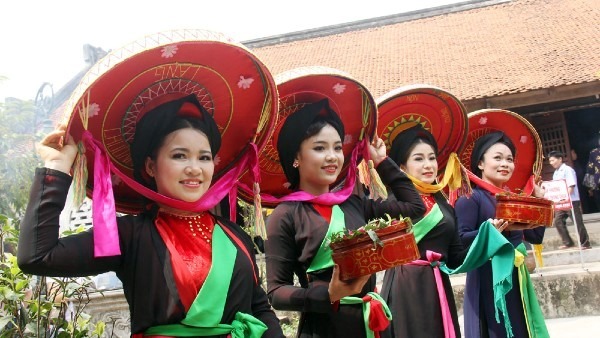
4. Bac Ninh folk music popular in these days
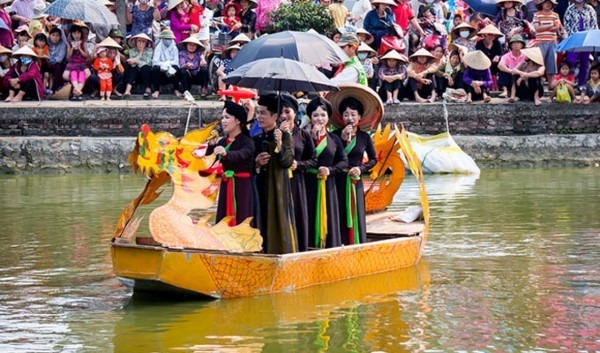
Every year, beginning on the 4th of the lunar calendar, the folk villages of the Bac Ninh family begin to bustle with the singing of the brothers and sisters in preparation for the highly significant holiday. You’ll love the lyrics, which are rustic but express the feelings of the residents of Beijing’s countryside. It should not be used there. Bac Ninh frequently hosts singing contests on January 10th and 11th of the lunar calendar, offering guests new experiences and unique feelings.
5. Conclusions
With its distinct traits, Quan Ho Bac Ninh folk has drawn both local and foreign visitors to explore the cultural environment that has been established over many generations. It is deserving of UNESCO’s recognition as an intangible cultural treasure. We hope that by reading this page, our dear visitors will gain important knowledge on that particular people type. I hope you have a great experience while on this festival grounds.
More: The Marble Mountains – The natural wonders given




Bài viết liên quan: